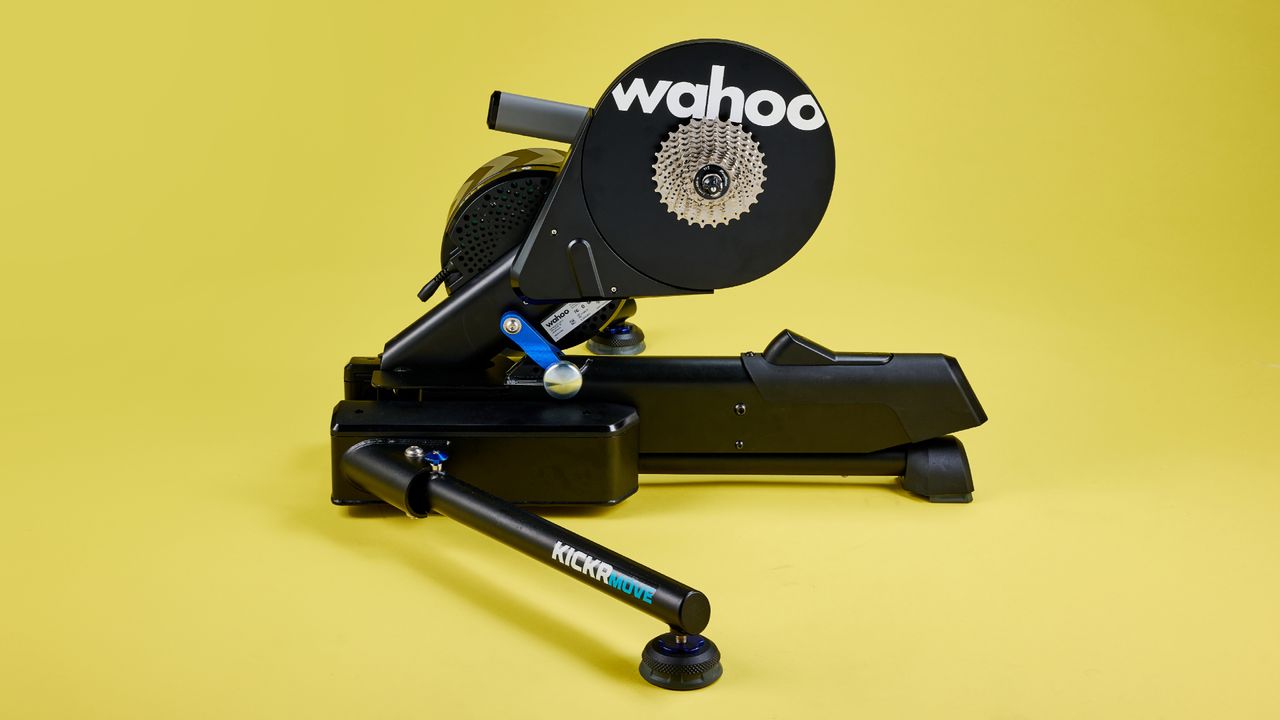Wahoo Kickr Move review - comfort boosting potential, but it's not for everyone
A good option for those who remain seated when riding indoors, but not great for high power and out-the-saddle efforts

The Wahoo Kickr Move is a good option for quite a specific user. Costing $300.00 / £300.00 more than the non-moving (but otherwise identical) Wahoo Kickr V6, there are full sized rocker plates which are available for a similar price - or a fair chunk cheaper, depending on discounts. Then again, the Kickr Move is easier to store than a full sized rocker plate - plus the fore/aft movement is much greater than what you get on cheaper rocker plates, and does increase the comfort when riding in the saddle. On the flipside of that greater range of movement from the Kickr Move means that riding out of the saddle feels unnatural and as though your watts are being wasted. It might be the case that the Wahoo Kickr Move will suit you well - but there are several scenarios where the non-moving version makes more sense.
-
+
Subtle and natural movement riding in the saddle
-
+
Improved comfort
-
+
Excellent power accuracy and max power
-
+
Wi-Fi, ANT and Bluetooth connectivity
-
-
Unnatural lateral movement
-
-
Unrealistic feel under power or out the saddle
-
-
Price
-
-
Size and weight
You can trust Cycling Weekly.
A necessary requirement of an indoor trainer is that it needs to attach onto the bike. Not only does this take something away from the feel of riding outdoors, it can also lead to discomfort when a rider is stuck in one position in the saddle.
There have been a few attempts to add movement into the system to improve comfort and feel, adding rocker plates is probably the most well-tried of these. In the Kickr Move, Wahoo has gone about things differently, integrating the movement into the trainer itself with the launch of the Wahoo Kickr Move. How well is this executed? And how does the Kickr Move compare to the best smart indoor bike trainers?
Wahoo Kickr Move: construction
The main guts of the Kickr Move are identical to the version 6 Kickr that was launched last year. This gives you a massive 2,200W max output and a power accuracy of +/- 1%; it also includes Wi-Fi connectivity for a faster connection when racing, the ERG Ramp function and a host of other high-end features.
The trainer is mounted on a 20cm curved track within its housing to give forward/backward movement. The track’s profile allows the trainer to move naturally and gently oscillate around its neutral position.
As well as forward and back, the Move’s construction also allow a smaller amount of lateral movement. This complements the side-to-side movement which is controlled by the cushioned AXIS, a feature of the standard Kickr direct-drive trainer.
The resulting two plane motion results in slight but constant movements which load and off-load contact points, something that is part and parcel of riding outdoors and critical to comfort.
Wahoo Kickr Move: set up
The Move comes ready equipped for 700c, 11sp standard freehub and 135mm QR axle. Parts are included to adjust for different wheel size or axles; different cassette or freehubs need to be bought separately. Set up of the hardware is extremely straightforward with videos tailored to your bike’s wheel and hub size and gearing.
Because of the lateral movement, you may need to spend more time tinkering with the virtual alignment of the trainer. The process of adjustment itself is simple but can take a little time to refine.
If you store your trainer away between rides it’s worth noting that the Move is significantly bigger and heavier than the static Kickr so is that much harder to shift (89cm vs 70cm width with legs fully extended; 29 vs 22kg).
Technological set up is the same as on the standard Kickr, you will just need to go through your various ANT+, Bluetooth and Wi-Fi connections, devices and apps to make sure the trainer can talk to all the right ones. It’s worth being frugal with the connections, output readings and ERG trainer settings can go a little awry if you have too many devices trying to connect at once.
Wahoo Kickr Move: the ride
Climbing on, the movement is quite prominent and disconcerting but that pretty much disappears once you start riding; in fact, when you’re spinning along, it's hardly noticeable at all. You can get a better idea of what’s going on if you carefully watch your bike when you’re riding in the saddle you will notice slight side-to-side and forward / back oscillations.
As subtle as the movement might be, the result is rather more significant; the Move is definitely more comfortable than the static Wahoo Kickr v6. I don’t really suffer from aches and pains riding indoors but can start to wriggle about during longer rides. Since riding on the Move I’ve been doing a lot less shuffling about which has allowed me to focus on the pedalling throughout the session. All good stuff, particularly if the quality or quantity of your indoor riding is limited by saddle or hand discomfort.
But there are less good bits too.
Unlike the forward movement, the side-to-side motion doesn’t occur within a curved track and so doesn’t have the same dampening and control. This makes the lateral movement feel limited, unnatural and lacking the control. It isn’t an issue when you’re spinning along but really noticeable the moment you get out the saddle or put the power down.
There are also instances when the forward movement feels false, typically if you reach out to a screen or bottle, or sit back down after an effort. More significantly if you’re riding at a higher power and lower cadence there can also be quite a lot of motion which can disturb your pedal stroke.
Wahoo Kickr Move: power analysis
As our previous analysis of power readings from the Kickr v6, readings from the Move support Wahoo’s claim of +/- 1% accuracy. The power smoothing settings within the Wahoo apps do a good job of tidying up your output if you prefer that to the raw and dirty version.
Wahoo Kickr Move: value and conclusion
The Kickr Move’s in-built motion certainly improves ride comfort. Even though the movement is barely tangible when you’re spinning along, it’s enough to load and off-load your weight where it matters. On the flip side when you put down the power or ride out the saddle the movement is less natural and arguably takes away from the ride feel.
And then there’s the price, $1,599.99 / £1,399.99 is a huge outlay. In the context of the static Kickr v6 ($1,299.99 / £1,099.99), $300.00 / £300.00 for the moving parts is more palatable and comparable to other movement systems.
As to whether it's good value, that is a different matter. If you struggle with discomfort during indoor sessions then it’ll be money well spent. If you’re the kind of rider who likes to power out the saddle, you will probably be better saving your pennies.
Specs
- Power accuracy: +/- 1%
- Max power: 2,200W
- Calibration: Auto
- Connectivity: Bluetooth, ANT+, WiFi, Direct Connect
- ERG: Easy Ramp
- Weight: 64lb / 29kg

Thank you for reading 20 articles this month* Join now for unlimited access
Enjoy your first month for just £1 / $1 / €1
*Read 5 free articles per month without a subscription

Join now for unlimited access
Try first month for just £1 / $1 / €1
Get The Leadout Newsletter
The latest race content, interviews, features, reviews and expert buying guides, direct to your inbox!
Rachel has been writing about and reviewing bike tech for the last 10 years. Cynical by nature, Rachel never really trusts the marketing hype and prefers to give products a mighty good testing before deciding whether they're worth buying or not.
Rachel's first riding love is mountain biking where she's been European and UK 24hr Champion on more than one occasion. She's not just confined to the trails though and regularly rides - and occasionally races - on gravel and road too.
-
 'It’s just crazy to be here' - American youngster Colby Simmons to make WorldTour debut at Tour of Flanders
'It’s just crazy to be here' - American youngster Colby Simmons to make WorldTour debut at Tour of FlandersAfter three years in WorldTour development programmes, the 21-year-old from Durango got his call-up
By Anne-Marije Rook Published
-
 Tadej Pogačar must attack from range at the Tour of Flanders - taking Mathieu van der Poel to the line is not an option
Tadej Pogačar must attack from range at the Tour of Flanders - taking Mathieu van der Poel to the line is not an optionSlovenian must look to replicate his Oude Kwaremont attack from 2023 if he wants to guarantee being first across the line in Oudenaarde
By Tom Thewlis Published
-
 108 Days, 18,125 miles: Lael Wilcox’s record-breaking ride hits the big screen with full-length documentary
108 Days, 18,125 miles: Lael Wilcox’s record-breaking ride hits the big screen with full-length documentary'Lael Rides Around the World' premieres at Sea Otter Classic and goes on an international tour
By James Shrubsall Published